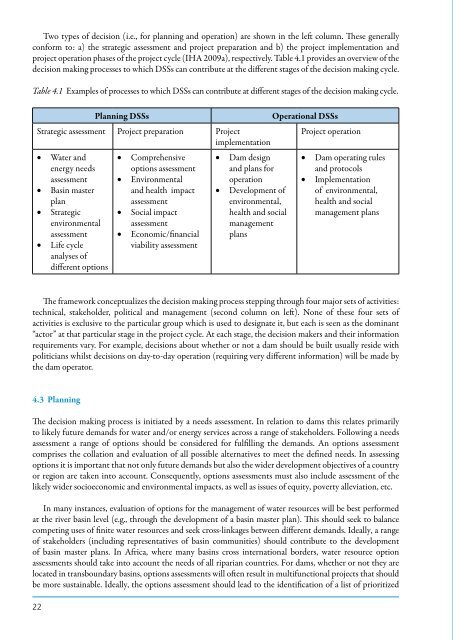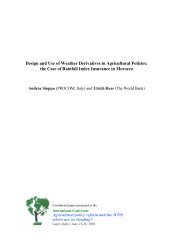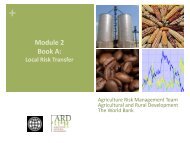Use of decision support systems to improve dam planning and dam ...
Use of decision support systems to improve dam planning and dam ...
Use of decision support systems to improve dam planning and dam ...
Create successful ePaper yourself
Turn your PDF publications into a flip-book with our unique Google optimized e-Paper software.
Two types <strong>of</strong> <strong>decision</strong> (i.e., for <strong>planning</strong> <strong>and</strong> operation) are shown in the left column. These generally<br />
conform <strong>to</strong>: a) the strategic assessment <strong>and</strong> project preparation <strong>and</strong> b) the project implementation <strong>and</strong><br />
project operation phases <strong>of</strong> the project cycle (IHA 2009a), respectively. Table 4.1 provides an overview <strong>of</strong> the<br />
<strong>decision</strong> making processes <strong>to</strong> which DSSs can contribute at the different stages <strong>of</strong> the <strong>decision</strong> making cycle.<br />
Table 4.1 Examples <strong>of</strong> processes <strong>to</strong> which DSSs can contribute at different stages <strong>of</strong> the <strong>decision</strong> making cycle.<br />
Planning DSSs Operational DSSs<br />
Strategic assessment Project preparation Project<br />
implementation<br />
Project operation<br />
• Water <strong>and</strong><br />
energy needs<br />
assessment<br />
• Basin master<br />
plan<br />
• Strategic<br />
environmental<br />
assessment<br />
• Life cycle<br />
analyses <strong>of</strong><br />
different options<br />
22<br />
• Comprehensive<br />
options assessment<br />
• Environmental<br />
<strong>and</strong> health impact<br />
assessment<br />
• Social impact<br />
assessment<br />
• Economic/financial<br />
viability assessment<br />
• Dam design<br />
<strong>and</strong> plans for<br />
operation<br />
• Development <strong>of</strong><br />
environmental,<br />
health <strong>and</strong> social<br />
management<br />
plans<br />
• Dam operating rules<br />
<strong>and</strong> pro<strong>to</strong>cols<br />
• Implementation<br />
<strong>of</strong> environmental,<br />
health <strong>and</strong> social<br />
management plans<br />
The framework conceptualizes the <strong>decision</strong> making process stepping through four major sets <strong>of</strong> activities:<br />
technical, stakeholder, political <strong>and</strong> management (second column on left). None <strong>of</strong> these four sets <strong>of</strong><br />
activities is exclusive <strong>to</strong> the particular group which is used <strong>to</strong> designate it, but each is seen as the dominant<br />
“ac<strong>to</strong>r” at that particular stage in the project cycle. At each stage, the <strong>decision</strong> makers <strong>and</strong> their information<br />
requirements vary. For example, <strong>decision</strong>s about whether or not a <strong>dam</strong> should be built usually reside with<br />
politicians whilst <strong>decision</strong>s on day-<strong>to</strong>-day operation (requiring very different information) will be made by<br />
the <strong>dam</strong> opera<strong>to</strong>r.<br />
4.3 Planning<br />
The <strong>decision</strong> making process is initiated by a needs assessment. In relation <strong>to</strong> <strong>dam</strong>s this relates primarily<br />
<strong>to</strong> likely future dem<strong>and</strong>s for water <strong>and</strong>/or energy services across a range <strong>of</strong> stakeholders. Following a needs<br />
assessment a range <strong>of</strong> options should be considered for fulfilling the dem<strong>and</strong>s. An options assessment<br />
comprises the collation <strong>and</strong> evaluation <strong>of</strong> all possible alternatives <strong>to</strong> meet the defined needs. In assessing<br />
options it is important that not only future dem<strong>and</strong>s but also the wider development objectives <strong>of</strong> a country<br />
or region are taken in<strong>to</strong> account. Consequently, options assessments must also include assessment <strong>of</strong> the<br />
likely wider socioeconomic <strong>and</strong> environmental impacts, as well as issues <strong>of</strong> equity, poverty alleviation, etc.<br />
In many instances, evaluation <strong>of</strong> options for the management <strong>of</strong> water resources will be best performed<br />
at the river basin level (e.g., through the development <strong>of</strong> a basin master plan). This should seek <strong>to</strong> balance<br />
competing uses <strong>of</strong> finite water resources <strong>and</strong> seek cross-linkages between different dem<strong>and</strong>s. Ideally, a range<br />
<strong>of</strong> stakeholders (including representatives <strong>of</strong> basin communities) should contribute <strong>to</strong> the development<br />
<strong>of</strong> basin master plans. In Africa, where many basins cross international borders, water resource option<br />
assessments should take in<strong>to</strong> account the needs <strong>of</strong> all riparian countries. For <strong>dam</strong>s, whether or not they are<br />
located in transboundary basins, options assessments will <strong>of</strong>ten result in multifunctional projects that should<br />
be more sustainable. Ideally, the options assessment should lead <strong>to</strong> the identification <strong>of</strong> a list <strong>of</strong> prioritized





